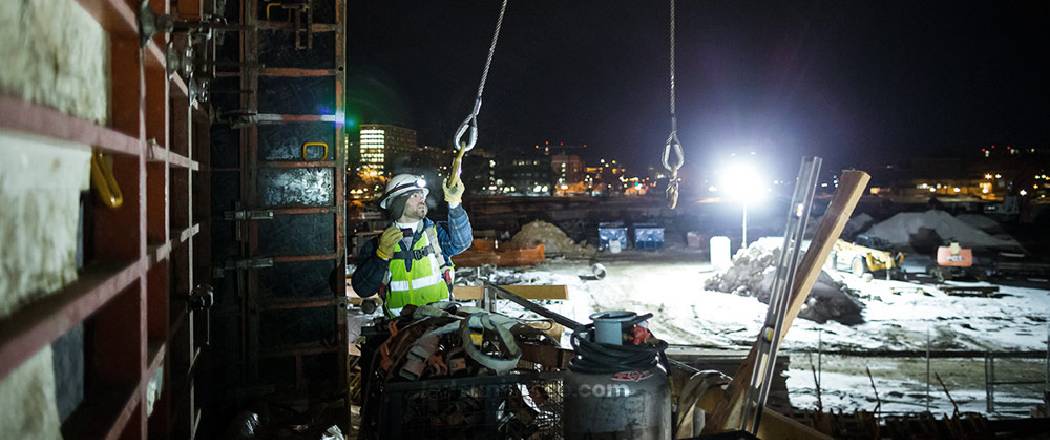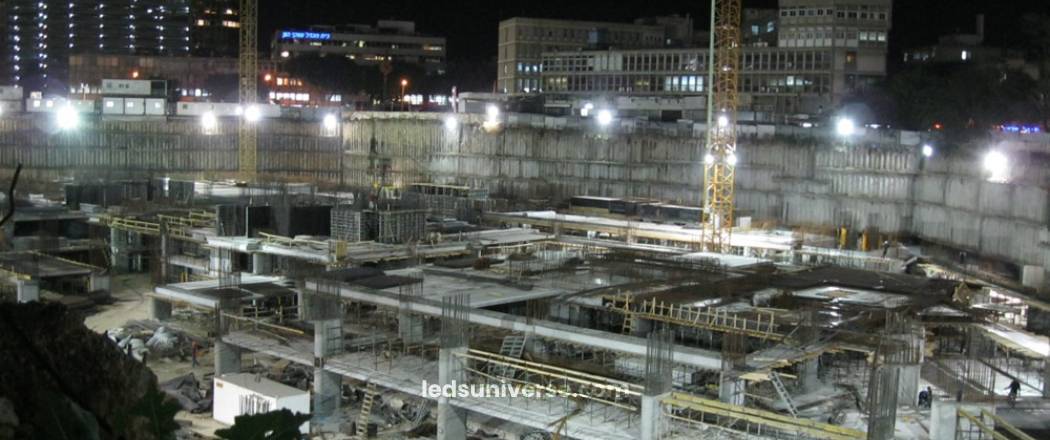As dusk falls and construction work presses on, the need for powerful lighting becomes undeniable. Bright, reliable illumination transforms a dark site into a secure, efficient workspace, where workers can see clearly and operate safely. LED floodlights, with their intense glow and energy-saving performance, have become the lifeblood of nighttime construction, turning once shadowy sites into vibrant hubs of productivity.
Nighttime activities at construction sites require careful planning to ensure that everyone can work safely. One of the most effective ways to ensure safety is through proper lighting. Lighting at night or during dusk hours is vital for workers as it enhances their visibility, helping to avoid potential accidents and improve workflow efficiency.
Before choosing a lighting fixture for a construction site, there are several aspects to consider. Each light fixture comes with its own set of specifications and performance indicators. Understanding these will help in making the best choice for your specific construction site needs.
Reach out for free lighting consultation
Table of Contents
ToggleFloodlights are commonly used for outdoor illumination due to their broad, high-intensity beams. These lights are frequently employed in various settings like stage performances, concerts, and sports events, making them versatile for large-scale lighting needs.
One of the most common types of floodlights is the metal halide lamp, which emits approximately 75–100 lumens per watt. Sodium vapor lamps, another popular option, are especially favored for sports events because they provide a more efficient lumen output, ranging between 150–180 lumens per watt.
In recent years, LED floodlights have become increasingly popular. Not only do they provide sufficient brightness for large areas, but they also have several advantages over traditional lighting options. LEDs offer instant startup, have a longer lifespan, and consume less power, making them an excellent choice for construction sites and other industrial environments.
Floodlight fixtures are designed to be durable, featuring metallic casings that protect them from harsh weather conditions, high temperatures, and physical damage. These fixtures typically use LED bulbs, halogen bulbs, or CFLs. While CFLs are more brittle and less popular, halogen bulbs are known for their brightness but have a shorter lifespan compared to LEDs.

The use of lighting at night in construction is governed by specific guidelines to ensure both worker safety and operational efficiency. Every construction site, whether relying on natural or artificial light, must be well-illuminated. If work continues after daylight hours, artificial lighting is required to provide safe conditions for workers.
Shadows can create hazardous conditions, especially near machinery. Construction sites must ensure that these areas are adequately lit to prevent accidents. Emergency lighting is another crucial consideration. In the event of a power outage, backup lighting should be immediately available to maintain visibility and allow workers to navigate the site safely.
When a construction site is located near residential areas or busy roads, light spillage can cause distractions. Careful design and placement of lighting fixtures can prevent this issue, ensuring that lighting serves its intended purpose without causing interference to others.
Regular maintenance is necessary to ensure lighting systems function properly.
Glare, flickering, and strobing must be avoided, as these can distract workers and reduce overall efficiency.
The lighting selected should be appropriate for the specific tasks being undertaken.
Lights must be clearly visible to workers so that any potential hazards can be identified and monitored.
The lighting system should not create any risks to worker health or safety.
Using different light colors can improve visibility and distinguish different work areas, enhancing safety.
LED lighting technology is widely used in construction sites due to its effectiveness in ensuring worker safety, reducing energy consumption, and offering long-lasting performance. LEDs are considered a reliable option for construction lighting, and here are several reasons why they are preferred.
Construction sites present numerous challenges and potential dangers, especially when working at night. Installing proper lighting is one way to minimize the risks of accidents and injuries. LED lights, which increase visibility, allow workers to see clearly and move safely around the construction site. This is especially vital when operating machinery or working in areas with heavy equipment.
Construction sites contain valuable equipment, tools, and materials, making them targets for theft or vandalism. Adequate lighting, including security lighting with motion sensors, can help deter criminal activity. With proper illumination, security personnel can easily detect unauthorized entry or suspicious behavior.
When construction sites are well-lit, workers can continue their tasks beyond regular daylight hours. This is particularly useful for projects that require additional time or involve tight deadlines. The enhanced visibility provided by LED floodlights makes it easier to work efficiently and safely, even late into the night.
Construction floodlights come in several varieties, each designed for different purposes and environments. The choice of lighting will depend on the specific needs of the construction site.
Portable light towers are versatile lighting fixtures that can be mounted on adjustable masts. These towers can be raised to different heights and positions, making them suitable for illuminating large construction areas. They are designed to be energy-efficient and weather-resistant, with some models able to use up to five times less energy than traditional lighting.
Their portability makes them easy to transport and set up. They are often equipped with wheels, allowing them to be moved around the site as needed. Some light towers can also provide additional power, eliminating the need for a generator. Many models can run for up to two hours on just four liters of fuel.
Balloon lighting is another option for large-scale construction lighting. Like portable light towers, balloon lights provide even, low-glare illumination over a wide area. They can be attached to portable light towers or machinery, making them useful for a range of construction environments.
Roadway luminaires are typically mounted on poles and have a hardwired electrical system. These lights are often used for temporary lighting along roadways near construction sites. Since installation is more complicated, professionals are required to mount and wire these luminaires.
Security lighting with motion sensors is commonly used at construction sites to detect unauthorized activity. These systems utilize infrared technology to monitor movement. When the sensor detects motion, a signal is sent to the control room, and security personnel can take appropriate action.
LED crane floodlights are lightweight yet powerful lighting fixtures commonly used at construction sites. They offer bright illumination over large areas and have the added benefit of instant startup, making them ideal for night work. These lights are often mounted on cranes, helping workers see clearly when working at height or across expansive areas.

LED lights have become the preferred option for construction site lighting due to their numerous benefits, ranging from durability to energy efficiency.
Construction sites are demanding environments where lights may be subjected to knocks, falls, or collisions. LED lights are made from durable materials like epoxy resin, making them far less likely to break than traditional glass bulbs. This durability reduces maintenance costs and ensures that the lights remain operational for extended periods.
LED lights use significantly less energy than traditional lighting options, while still providing excellent illumination. This makes them a more cost-effective choice for construction sites, where numerous lights may be required for long periods.
In addition to their low energy consumption, LEDs can be connected in series without overloading electrical circuits. This makes them a practical choice for large-scale construction projects.
LED lights contribute to a safer working environment by improving visibility. They also comply with Occupational Safety and Health Administration (OSHA) standards for workplace lighting. Unlike some traditional lighting options, LEDs do not contain hazardous materials like mercury, making them a safer choice for workers and the environment.
Switching to LED lights can result in significant cost savings. Not only do they use less energy, but they also last much longer than other types of bulbs, reducing the need for replacements. This longevity and efficiency make them a wise investment for construction companies.
LED lights have proven their reliability over time, providing consistent illumination across construction sites. They are available in a range of brightness levels and color temperatures, allowing construction managers to select the lighting that best suits their specific needs.
LED lights comply with environmental safety regulations, such as the Restriction of Hazardous Substances (ROHS) directive. This ensures that they do not contain harmful substances and that their use contributes to maintaining a safe work environment.
Floodlights are often used in outdoor areas where strong, broad illumination is required. Construction sites are one of the most common environments for floodlights, but they are also found in many other settings.
Floodlights are commonly used in various industrial and commercial spaces due to their ability to provide strong, broad illumination. These lights are frequently installed in locations such as warehouses, streets, outdoor arenas, driveways, sports fields, and stadiums. Their wide, bright coverage makes them an ideal choice for enhancing visibility in large open areas, ensuring safety and functionality in both public and private spaces.
Each of these areas benefits from the wide, bright coverage that floodlights provide, making them a versatile lighting solution.
LED floodlights stand out as the preferred choice due to their durability, energy efficiency, and ability to provide bright, even illumination. By illuminating potential hazards and enhancing visibility, these lighting solutions not only protect workers but also deter theft and vandalism, ensuring that valuable equipment remains secure. The various types of floodlights, such as portable light towers and security lighting with motion sensors, offer flexibility and adaptability to meet the unique needs of each construction environment. As construction projects increasingly extend into the night, investing in high-quality LED lighting systems proves to be a wise decision, contributing to smoother operations and a safer work atmosphere.